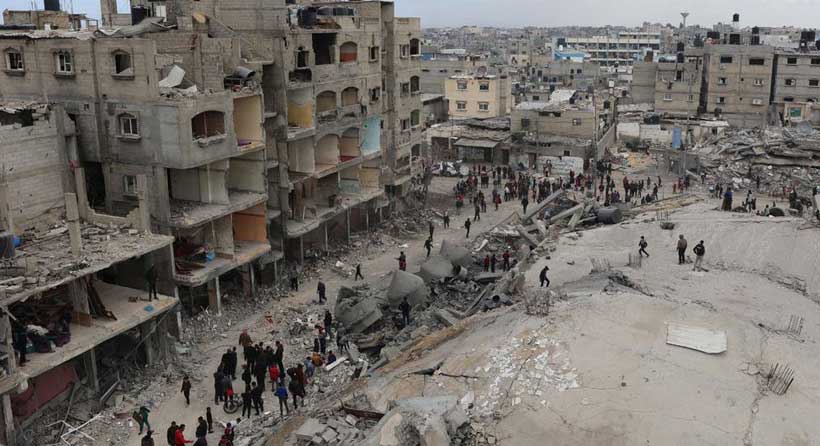Although the war in Gaza continues, debates over its aftermath are already intensifying — focusing not only on the challenge of reconstruction but also on the critical question of governance. As a fragile ceasefire teeters on the brink, competing visions for Gaza’s future have emerged, shaped by entrenched political interests, historical grievances, and strategic calculations.
On February 21, leaders of Gulf Arab states convened in Riyadh for high-level talks with their Egyptian and Jordanian counterparts to formulate a response to President Trump’s controversial proposal to redevelop Gaza under US administration and relocate its Palestinian population. The meeting, a prelude to the upcoming Arab League summit in Cairo on March 4, ended without an official statement, leaving uncertainty over whether a unified Arab stance will emerge, what options may be on the table, and how viable any alternative might be.
The High Cost of Conflict
The current conflict erupted following the October 7, 2023, Hamas attack on Israel, which resulted in 1,200 deaths and approximately 250 hostages. In retaliation, Israel launched a military campaign that has claimed the lives of over 48,000 Gazans. According to the UN Office for the Coordination of Humanitarian Affairs (OCHA), the war in Gaza has displaced at least 90% of the enclave’s 2.1 million residents. The February 2025 Interim Rapid Damage and Needs Assessment (IRDNA), produced jointly by the UN, EU, and World Bank reported that more than 292,000 homes have been damaged or demolished, 95% of hospitals are non-operational, and the local economy has contracted by 83%. The catastrophic toll extends to agriculture, where vast tracts of critical land have been degraded, livestock decimated, and local food production all but collapsed.
Despite intermittent moments of calm, the ceasefire remains precarious. Hamas, while continuing to release hostages in small groups under a series of fragile agreements, has yet to secure a lasting cessation of hostilities. With the current ceasefire set to expire on March 1 if negotiations falter, the urgency of forging a viable postwar framework for Gaza has never been more acute.
Four Competing Governance Models
At the heart of the postwar debate lie four competing governance models, each reflecting different visions for Gaza’s future:
Weakened Hamas Rule: After 17 years in power, Hamas is increasingly weakened, reduced to scattered guerrilla units, and facing a dramatic drop in public support — from 64% in June to 39% in September 2024, according to the Palestinian Center for Policy and Survey Research. Despite this decline, the complete eradication of Hamas remains unlikely. Moreover, Israeli Prime Minister Benjamin Netanyahu, who vowed to destroy Hamas, rejects any possibility of its return, while international donors have declared that reconstruction funds will only flow if Hamas steps aside in favor of an alternative Palestinian leadership.
Israeli Reoccupation: Some voices within Israel advocate for a full-scale reoccupation of Gaza, reimposing direct military control over the territory. However, this model is fraught with peril. According to a Pew Research Center survey conducted last May, a40% plurality of Israelis think Israel should govern the Gaza Strip. However, this model risks provoking fierce resistance, inviting international condemnation, and jeopardizing relations with key regional players such as Egypt and Jordan. Moreover, opinions within Israel remain deeply divided on whether long-term military governance is sustainable or conducive to lasting peace.
International Mandate: Several proposals have emerged for UN involvement in Gaza and the West Bank, including the Arab League’s call last May for the deployment of UN peacekeepers and suggestions for placing Palestine under UN trusteeship. This model envisions an international mandate that could temporarily stabilize the region until a more permanent political solution is reached. Nevertheless, the logistics of such a deployment are daunting, many nations are wary of assuming the associated financial and security burdens, and the persistent role of Hamas further complicates this approach.
Reformed Palestinian Authority (PA): Perhaps the most frequently discussed alternative is to reintegrate Gaza under the PA, which already governs the West Bank. This model aims to unify Palestinian governance under one umbrella, though the PA faces significant challenges — including widespread criticism for corruption, deep unpopularity among many Gazans, and skepticism from Israeli officials regarding its capacity to ensure security. Still, some Arab states, including Saudi Arabia and Egypt, view a revitalized PA as a potential stabilizing force that aligns with their broader regional strategies.
Together, these four models — Weakened Hamas Rule, Israeli Reoccupation, International Mandate, and Reformed Palestinian Governance — capture the range of proposals under consideration and reflect the intricate balance between internal discord and external influences, emphasizing the formidable task of creating a cohesive postwar governance structure for Gaza.
Regional, International, and Internal Dynamics
To fully understand Gaza’s future, it is essential to consider the external pressures exerted by regional and global powers as well as the deep internal divisions within Palestinian leadership. These intertwined dynamics are evident as key Arab states — Saudi Arabia, Egypt, Jordan, and the United Arab Emirates (UAE) — strategically maneuver to shape Gaza’s future, in part responding to the fragmented Palestinian political landscape. This complex interplay of internal and external factors sets the stage for the influential role of US policy, especially the controversial approach championed by President Donald Trump.
US Policy and the Trump Factor
A significant flashpoint in these discussions is the controversial vision put forward by U.S. President Donald Trump. His plan, which calls for the forced displacement of Gaza’s Palestinian population to facilitate a US-led takeover and transform the territory into a “Middle East Riviera,” has been met with fierce opposition from Arab states and many within the international community. Nearly 70% of Israelis support Trump’s proposal, but key regional figures, including Jordan’s King Abdullah II and Egyptian Foreign Minister Badr Abdelatty, have rejected it.
The Trump administration’s aggressive stance has not only deepened regional divisions but also signaled a broader shift in US policy — one that appears more willing to support militarized solutions than previous administrations. Recent developments, such as the recent delivery of heavy ordnance to Israel, underscore this divergence and further complicate the diplomatic landscape. Trump and Secretary of State Marco Rubio have also expressed support for resuming the war in Gaza, even as diplomatic efforts continue to broker a permanent ceasefire.
The Emergence of an Egyptian Proposal
Amid these competing visions, Egypt has emerged as a pivotal player, seeking to forge a path that diverges sharply from Trump’s model. Egypt is leading an effort among Arab states to construct an alternative governing structure for Gaza. In a direct rebuke to Trump’s proposal to depopulate the territory, Egypt is formulating a plan to rebuild Gaza without displacing its Palestinian residents. In stark contrast to Trump’s model—which advocates forced displacement and a US-led takeover — Egypt’s proposal seeks to preserve Gaza’s Palestinian population, highlighting the divergent external visions shaping the region’s postwar future.
According to the state-run Al-Ahram, the Egyptian plan would establish “secure areas” within Gaza where Palestinians could temporarily reside. During this period, Egyptian and international construction firms would work to rehabilitate the region’s shattered infrastructure. This initiative is set to be further developed at an emergency Arab summit scheduled for March 4, where leaders will outline a three-phase reconstruction plan aimed at restoring Gaza while safeguarding the rights of its inhabitants.
A critical element of the Egyptian proposal is the exclusion of Hamas from governance and reconstruction efforts. Under this plan, an interim — comprising technocrats and community leaders without ties to Hamas — would be established to oversee the rebuilding process. While Hamas has signaled a willingness to step aside administratively in the postwar period, aligning itself with US-led ceasefire extension efforts, the group’s refusal to disarm remains a significant sticking point. Israel’s insistence that Hamas be disarmed poses a serious challenge to the viability of any arrangement that seeks to marginalize the group, casting doubt on whether both Hamas and Israeli actors can ultimately endorse such a framework.
The Egyptian initiative faces significant skepticism, burdened by the failures of past efforts like the 2014 Gaza Reconstruction Mechanism (GRM). Designed by the UN to address Israeli concerns over Hamas diverting resources for tunnel construction, the GRM became an overly bureaucratic, underfunded, and ultimately ineffective endeavor — further weakened by Israel’s veto power. This history looms over current proposals, highlighting the deep challenges of postwar reconstruction in Gaza. Crucially, the plan also sidesteps a core issue: Israel rejects any postwar framework leading to a two-state solution, while Palestinians and Arab nations insist on a sovereign Palestine.
Palestinian Leadership and Internal Divisions
While Hamas and the Palestinian Authority (PA) share a united front in opposing President Trump’s displacement plan for Gaza, they remain deeply divided over the territory’s future governance. Palestinian President Mahmoud Abbas, who once boycotted Trump over the US Embassy’s relocation to Jerusalem, has now re-engaged with the White House presumably to influence postwar outcomes. In a notable overture to the Trump administration, Abbas recently signed a decree ending payments to families of Palestinians who attack Israelis — a move that mirrors the US Taylor Force Act, which had previously cut aid to the PA over similar practices.
Despite these efforts, the PA is widely unpopular among Palestinians. Struggling to rein in a new wave of Palestinian militancy in the West Bank, its legitimacy continues to erode under the weight of Israeli settlement expansion. Many Palestinians see Fatah, along with 88-year-old President Mahmoud Abbas and his administration, as corrupt, undemocratic — highlighting the significant challenges it faces in effectively governing Gaza. Repeated attempts to bridge the Fatah-Hamas divide, most recently a July 2024 agreement brokered by China to establish an “interim national reconciliation government” for Gaza, have failed. Thus, the persistent splits within Palestinian factions not only hampers unified governance but also intensifies the broader challenges of mobilizing international support and resources for Gaza’s reconstruction.
The Financial Conundrum: The “Easy Part” or an Insurmountable Hurdle?
On the surface, assembling billions for reconstruction might seem like the “easy part” of the postwar equation. Yet the February IRDNA joint assessment paints a sobering picture: over $53 billion will be required to rebuild Gaza and the West Bank, with at least $20 billion needed in the first three years alone. The staggering cost, coupled with the absence of a clear funding mechanism, underscores the deep financial uncertainties that haunt every proposal. Without reliable international donor commitments and a robust financial strategy, even the most carefully crafted governance models could founder.
Governance: Who Gets to Decide?
Beyond the finances lies the thorny issue of governance. Egypt’s proposal to establish a technocratic committee — comprising experts tasked with overseeing Gaza’s reconstruction — offers one potential pathway forward. However, this plan is not without its critics. Central to the debate is whether the Palestinian Authority (PA), which many view as both corrupt and ineffective, would be willing to endorse an arrangement that effectively sidelines its own influence.
Moreover, the role of Hamas remains a flashpoint. Although the group has signaled a willingness to step aside in the postwar phase — at least as a temporary measure aligned with US-led ceasefire extensions — Israel’s insistence that Hamas disarm casts a long shadow over any future governance structure. The discord between the demands of Israel, the aspirations of Arab states, and the internal division within Palestinian leadership makes it difficult to envision a unified and stable administrative framework.
The Security Dilemma
No discussion of postwar Gaza is complete without addressing the crucial issue of security. For many Israeli officials, long-term military freedom in Gaza is non-negotiable. A permanent or semi-permanent Israeli military presence is seen as essential to prevent future hostilities. Yet such an arrangement is likely to be met with fierce opposition from both Arab leaders and Palestinian factions. The unresolved military status of Hamas — coupled with the broader regional mistrust — poses a significant barrier to any security arrangement that could be acceptable to all parties. Moreover, the prospect of deploying an international security force or expanding the role of Arab military intervention further complicates the picture, as neither option is likely to garner unanimous support.
A Contested Road Ahead
The postwar future of Gaza remains deeply uncertain, shaped by competing governance models, unresolved political disputes, and daunting financial and security challenges. Whether Gaza’s governance falls to a weakened Hamas, Israeli reoccupation, an international mandate, or a reformed Palestinian administration, the lack of consensus ensures a fraught path forward. The staggering financial requirements, coupled with unresolved questions about governance and security, further underscore the enormity of the task.
Regional dynamics only add to the complexity. Arab states, seeking a role in shaping Gaza’s future while countering US policies, remain divided by strategic rivalries and historical tensions, making a unified approach elusive. The Trump administration’s calls for forced displacement and militarized oversight have only deepened these divisions. Meanwhile, with critical donor support hanging in the balance, the window for a stable and comprehensive solution appears narrow.
The coming months will be pivotal. As the ceasefire teeters on the brink of expiration and diplomatic efforts intensify, the pressure to forge a viable postwar framework will mount. Yet every element of the equation — from the financial blueprint to the governance structure and the security apparatus — remains fraught with uncertainty. Without a cohesive strategy that reconciles the divergent interests of Israeli, Arab, and Palestinian actors, Gaza risks remaining a fragmented and volatile territory, perpetually caught between external pressures and internal divisions.
Yet regardless of which long-term rebuilding model prevails, urgent humanitarian assistance must be delivered in parallel with reconstruction efforts. Moreover, any successful plan will require that the voices of Gazans be heard and that they are actively engaged in the rebuilding process.
Ultimately, the contest over Gaza’s postwar governance reflects broader regional struggles — over power, legitimacy, and the future of Palestinian statehood. Whether any model can provide lasting stability will not only shape Gaza’s fate but will have far-reaching consequences for the entire Middle East.








